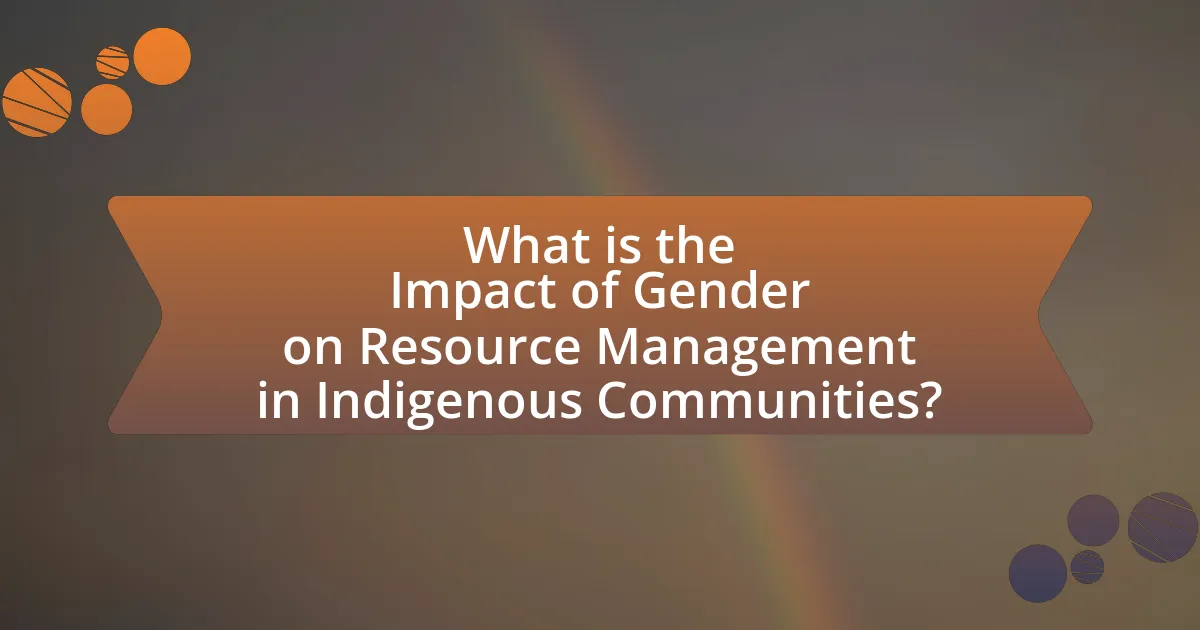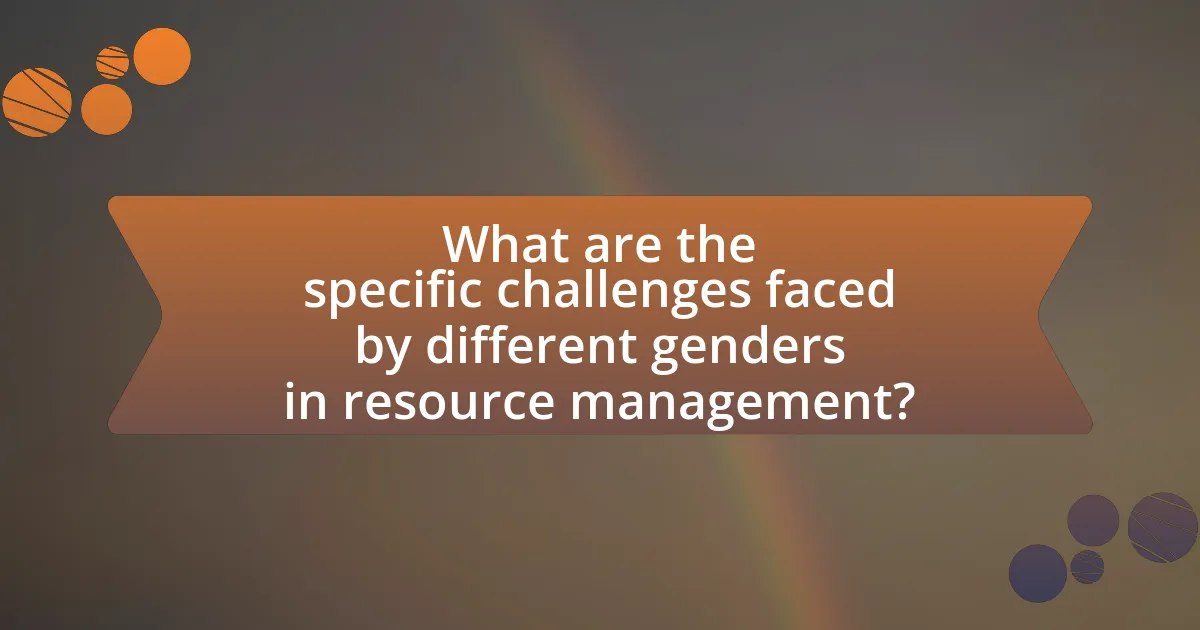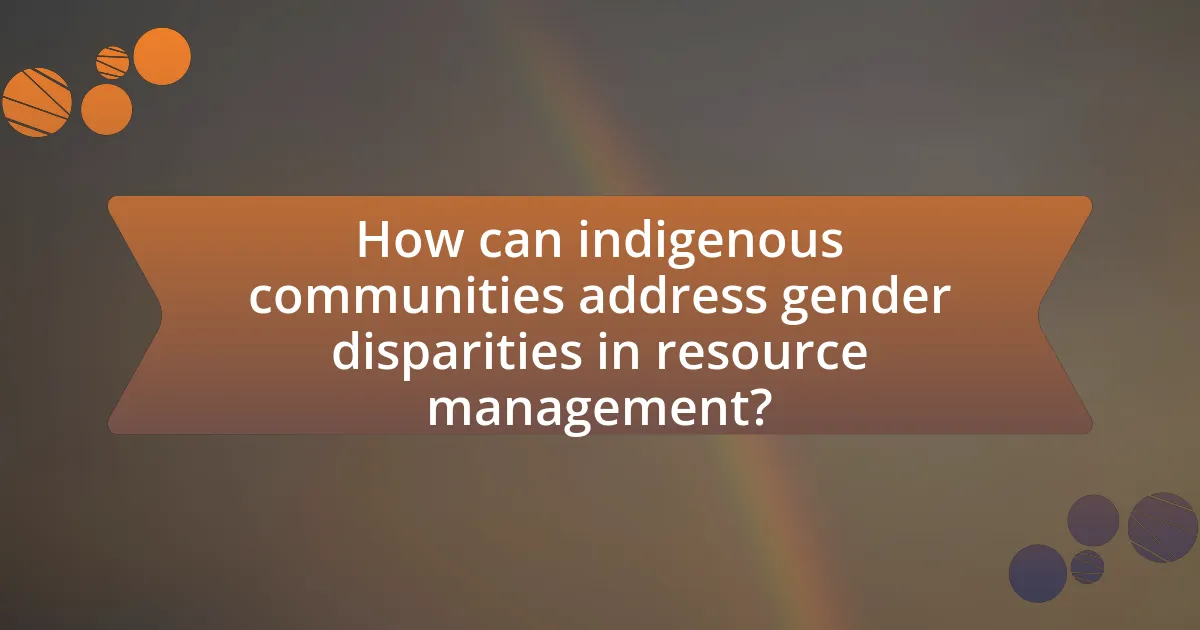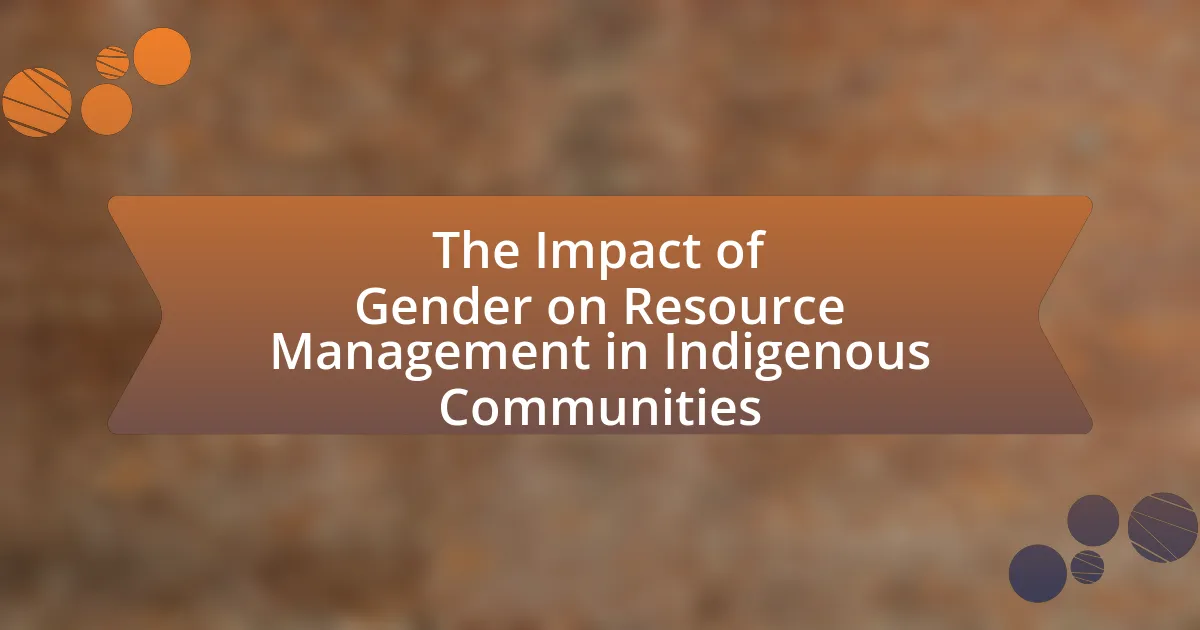The article examines the significant impact of gender on resource management within Indigenous communities, highlighting how gender roles influence decision-making, access to resources, and sustainability practices. It discusses the distinct roles of men and women in resource management, the cultural perceptions that shape resource allocation, and the importance of integrating gender perspectives for equitable outcomes. The article also addresses the challenges faced by different genders, particularly women, in accessing resources and decision-making positions, and emphasizes the benefits of gender-inclusive practices for enhancing resource sustainability and community resilience. Key strategies for promoting gender equity in resource management are outlined, including education, community-led initiatives, and collaborative approaches that leverage the strengths of both genders.

What is the Impact of Gender on Resource Management in Indigenous Communities?
The impact of gender on resource management in Indigenous communities is significant, as it influences decision-making, access to resources, and the sustainability of practices. Gender roles often dictate who has authority over resource management, with men typically holding leadership positions while women may be responsible for daily resource use and management. This division can lead to unequal access to resources and limit women’s participation in decision-making processes. Research indicates that when women are included in resource management, communities often experience improved outcomes, such as enhanced biodiversity and more sustainable practices, as evidenced by studies showing that women’s knowledge contributes to better environmental stewardship.
How does gender influence decision-making in resource management?
Gender significantly influences decision-making in resource management by shaping perspectives, priorities, and access to resources. In many indigenous communities, women often play a crucial role in managing natural resources, leading to different approaches compared to male counterparts. Research indicates that women typically prioritize sustainability and community welfare, while men may focus on economic gains. For instance, a study by the Food and Agriculture Organization (FAO) highlights that women’s involvement in resource management can enhance biodiversity conservation and improve food security. This evidence underscores the importance of integrating gender perspectives in decision-making processes to achieve more equitable and effective resource management outcomes.
What roles do men and women play in resource management?
Men and women play distinct yet complementary roles in resource management within indigenous communities. Men typically engage in activities such as hunting, fishing, and logging, which are often seen as traditional male roles, while women are primarily responsible for gathering, agriculture, and managing household resources. This division of labor is rooted in cultural practices and social norms that dictate gender roles.
Research indicates that women often possess critical knowledge about local ecosystems and resource sustainability, which is essential for effective management. For instance, a study by the Food and Agriculture Organization highlights that women’s involvement in agriculture can lead to increased productivity and better resource conservation. Additionally, when both genders collaborate in resource management, it enhances decision-making processes and leads to more sustainable outcomes. This collaborative approach is supported by evidence from various indigenous communities, demonstrating that integrating both men’s and women’s perspectives results in more effective resource management strategies.
How do cultural perceptions of gender affect resource allocation?
Cultural perceptions of gender significantly influence resource allocation by determining who has access to resources and decision-making power within communities. In many indigenous cultures, traditional gender roles often dictate that men control land and financial resources, while women may be relegated to domestic roles, limiting their access to economic opportunities. For instance, a study by the Food and Agriculture Organization (FAO) found that in regions where women are viewed primarily as caregivers, they receive less support for agricultural initiatives, resulting in lower productivity and economic growth. This disparity in resource allocation not only affects individual livelihoods but also impacts community development and sustainability, as women’s contributions to resource management are often undervalued or overlooked.
Why is understanding gender dynamics important in indigenous resource management?
Understanding gender dynamics is crucial in indigenous resource management because it influences decision-making, resource allocation, and community resilience. Gender roles often dictate who has access to resources and who participates in management practices, which can lead to unequal benefits and sustainability challenges. For instance, research indicates that when women are included in resource management, communities experience improved outcomes, such as enhanced biodiversity and better food security. This is supported by studies showing that women’s involvement in agriculture and natural resource management leads to more effective and sustainable practices, as they often possess unique knowledge and skills relevant to these areas. Therefore, recognizing and integrating gender dynamics is essential for equitable and effective resource management in indigenous communities.
What are the consequences of neglecting gender perspectives?
Neglecting gender perspectives leads to ineffective resource management and exacerbates inequalities within indigenous communities. When gender considerations are overlooked, the unique needs and contributions of women and marginalized groups are ignored, resulting in policies that fail to address the realities of all community members. For instance, research by the Food and Agriculture Organization (FAO) indicates that women play a crucial role in agricultural production and resource management, yet their exclusion from decision-making processes can lead to decreased productivity and sustainability. Furthermore, neglecting gender perspectives can perpetuate cycles of poverty and limit access to resources, as evidenced by studies showing that communities that integrate gender equality into resource management strategies experience improved economic outcomes and social cohesion.
How can gender-inclusive practices improve resource sustainability?
Gender-inclusive practices can improve resource sustainability by ensuring diverse perspectives and knowledge systems are integrated into resource management strategies. Research indicates that when women participate in decision-making processes, resource management becomes more effective and equitable, leading to better environmental outcomes. For instance, a study by the Food and Agriculture Organization found that women’s involvement in agricultural practices can increase crop yields by 20-30%, demonstrating that gender inclusivity directly enhances resource productivity and sustainability.

What are the specific challenges faced by different genders in resource management?
Different genders face distinct challenges in resource management, particularly in indigenous communities. Women often encounter barriers such as limited access to decision-making processes and resources, which can hinder their ability to manage land and water effectively. For instance, a study by the Food and Agriculture Organization (FAO) highlights that women in many indigenous communities are underrepresented in leadership roles, impacting their influence over resource allocation. Conversely, men may face challenges related to traditional expectations and roles that can restrict their participation in community-based resource management initiatives. Research indicates that these gender norms can limit men’s engagement in sustainable practices, as they may prioritize short-term economic gains over long-term resource sustainability. Overall, the intersection of gender roles and resource management creates unique obstacles that require tailored approaches to address effectively.
What barriers do women encounter in resource management roles?
Women encounter several barriers in resource management roles, including systemic discrimination, lack of access to decision-making positions, and insufficient support networks. Systemic discrimination manifests in biases that favor male leadership, limiting women’s opportunities for advancement. Research indicates that women are underrepresented in leadership roles within resource management, with only 30% of leadership positions held by women in many sectors. Additionally, women often face challenges in accessing funding and resources necessary for effective management, as studies show that female-led initiatives receive significantly less financial support compared to their male counterparts. Furthermore, cultural norms and expectations can hinder women’s participation, particularly in indigenous communities where traditional roles may restrict their involvement in resource management activities.
How do socio-economic factors impact women’s participation?
Socio-economic factors significantly impact women’s participation in resource management within indigenous communities by influencing their access to education, economic opportunities, and decision-making roles. For instance, women in lower socio-economic strata often face barriers such as limited access to education and financial resources, which restrict their ability to engage in resource management activities. Research indicates that in many indigenous communities, women who have higher educational attainment are more likely to participate in decision-making processes related to resource management, as evidenced by a study conducted by the International Fund for Agricultural Development, which found that women’s participation in agricultural decision-making increased by 30% when they had access to education and financial resources. Thus, socio-economic factors play a crucial role in shaping the extent and effectiveness of women’s involvement in these critical areas.
What legal and institutional challenges affect women’s rights to resources?
Legal and institutional challenges that affect women’s rights to resources include discriminatory laws, lack of access to legal recourse, and inadequate representation in decision-making processes. Discriminatory laws often limit women’s ownership and control over land and resources, as seen in many countries where traditional customs prioritize male inheritance. Additionally, women frequently face barriers in accessing legal systems, which can prevent them from asserting their rights effectively. For instance, a study by the World Bank indicates that in many regions, women are less likely to own land than men, with only 13% of women globally holding land titles. Furthermore, women’s underrepresentation in governance structures means their needs and perspectives are often overlooked in resource management policies, exacerbating inequalities.
How do men’s roles in resource management differ from women’s?
Men’s roles in resource management typically involve decision-making and leadership positions, while women’s roles often focus on the practical aspects of resource use and management. In many indigenous communities, men are frequently tasked with overseeing resource allocation and strategic planning, reflecting traditional gender norms that associate men with authority. Conversely, women often engage in the day-to-day management of resources, such as gathering, processing, and utilizing natural resources for household needs, which is crucial for community sustenance. Research indicates that in various indigenous cultures, women’s knowledge of local ecosystems and resource management practices is vital, yet their contributions are often undervalued compared to men’s leadership roles. This division of labor highlights the differing societal expectations and responsibilities assigned to each gender in resource management contexts.
What traditional practices reinforce gender roles in resource management?
Traditional practices that reinforce gender roles in resource management include the division of labor based on gender, where men are often assigned tasks related to hunting and fishing, while women are typically responsible for gathering, agriculture, and domestic resource management. This division is rooted in cultural beliefs and historical precedents that dictate specific roles for men and women, thereby perpetuating gender-specific responsibilities. For instance, in many Indigenous communities, rituals and customs surrounding resource allocation and usage often emphasize male authority in decision-making processes, further entrenching these roles. Studies have shown that such practices can limit women’s access to resources and decision-making power, reinforcing existing inequalities in resource management.
How can men’s involvement in gender equity initiatives enhance resource management?
Men’s involvement in gender equity initiatives can enhance resource management by promoting inclusive decision-making and leveraging diverse perspectives. When men actively participate in these initiatives, they contribute to a balanced approach that recognizes the unique roles and knowledge of all genders, particularly in indigenous communities where traditional practices often dictate resource use. Research indicates that inclusive governance leads to improved resource management outcomes; for instance, a study by the International Union for Conservation of Nature found that gender-inclusive practices can increase the effectiveness of natural resource management by up to 30%. This involvement fosters collaboration, reduces conflicts, and ensures that resource management strategies are more equitable and sustainable.

How can indigenous communities address gender disparities in resource management?
Indigenous communities can address gender disparities in resource management by implementing inclusive decision-making processes that actively involve women in leadership roles. Research shows that when women participate in resource management, it leads to more sustainable practices and improved community outcomes. For instance, a study by the International Union for Conservation of Nature found that women’s involvement in natural resource management enhances biodiversity conservation and increases community resilience. By prioritizing gender equity in leadership and decision-making, indigenous communities can effectively leverage the unique perspectives and knowledge of women, thereby addressing existing disparities and fostering more equitable resource management practices.
What strategies can be implemented to promote gender equity?
To promote gender equity, strategies such as implementing inclusive policies, providing education and training, and ensuring equal access to resources can be utilized. Inclusive policies that address gender disparities in resource management empower women in indigenous communities, as evidenced by the United Nations’ Sustainable Development Goals, which emphasize gender equality as essential for sustainable development. Education and training programs tailored for women enhance their skills and knowledge, leading to better participation in decision-making processes. Furthermore, ensuring equal access to resources, such as land and financial support, has been shown to improve economic outcomes for women, as highlighted in the World Bank’s report on gender and development, which states that closing gender gaps in access to resources can significantly boost productivity and economic growth.
How can education and training empower women in resource management?
Education and training empower women in resource management by equipping them with the necessary skills and knowledge to effectively manage resources. This empowerment leads to increased participation of women in decision-making processes, enhancing their influence in community resource management. For instance, a study by the Food and Agriculture Organization (FAO) found that when women receive training in sustainable agricultural practices, they can significantly improve crop yields and resource efficiency, thereby contributing to food security and economic stability in their communities. Furthermore, education fosters leadership skills among women, enabling them to advocate for sustainable practices and equitable resource distribution, which is crucial in indigenous communities where resource management is often tied to cultural and environmental sustainability.
What role do community-led initiatives play in addressing gender issues?
Community-led initiatives play a crucial role in addressing gender issues by empowering local populations to identify and tackle their specific challenges. These initiatives often foster inclusive decision-making processes, ensuring that women’s voices are heard and considered in resource management. For instance, research has shown that when women participate in community-led projects, there is a significant increase in sustainable practices and equitable resource distribution. A study by the International Union for Conservation of Nature found that communities with active female participation in resource management reported improved environmental outcomes and enhanced social cohesion. This evidence underscores the effectiveness of community-led initiatives in promoting gender equality and addressing related issues within indigenous communities.
What best practices can be adopted for inclusive resource management?
Best practices for inclusive resource management include engaging diverse stakeholders, ensuring equitable access to resources, and integrating traditional knowledge with modern practices. Engaging diverse stakeholders, such as women and marginalized groups, fosters a more comprehensive understanding of community needs and enhances decision-making processes. Ensuring equitable access to resources addresses historical inequalities, promoting social justice and sustainability. Integrating traditional knowledge with modern practices respects cultural heritage and enhances resource management effectiveness, as evidenced by studies showing that communities utilizing both approaches achieve better environmental outcomes.
How can collaboration between genders lead to better resource outcomes?
Collaboration between genders can lead to better resource outcomes by integrating diverse perspectives and skills, which enhances decision-making processes. Research indicates that gender-diverse teams are more innovative and effective in problem-solving, as they draw on a wider range of experiences and viewpoints. For instance, a study published in the Journal of Environmental Management found that mixed-gender groups in resource management settings were able to identify more sustainable practices compared to single-gender groups. This collaborative approach not only improves the efficiency of resource use but also fosters community engagement and ownership, leading to more sustainable outcomes in indigenous communities.
What are the key indicators of successful gender-inclusive resource management?
Key indicators of successful gender-inclusive resource management include equitable participation of all genders in decision-making processes, access to resources and benefits, and the integration of gender perspectives in policy and planning. Research shows that when women and marginalized genders are actively involved, resource management outcomes improve, leading to enhanced sustainability and community resilience. For instance, a study by the Food and Agriculture Organization highlights that gender-inclusive practices can increase agricultural productivity by 20-30%, demonstrating the tangible benefits of such approaches.
What practical steps can indigenous communities take to improve gender equity in resource management?
Indigenous communities can improve gender equity in resource management by implementing inclusive decision-making processes that actively involve women in leadership roles. Research indicates that when women participate in resource management, it leads to more sustainable practices and better community outcomes. For instance, a study by the International Union for Conservation of Nature found that women’s involvement in fisheries management resulted in improved fish stocks and community resilience. Additionally, providing education and training programs tailored for women can enhance their skills and confidence in resource management, further promoting equity.
